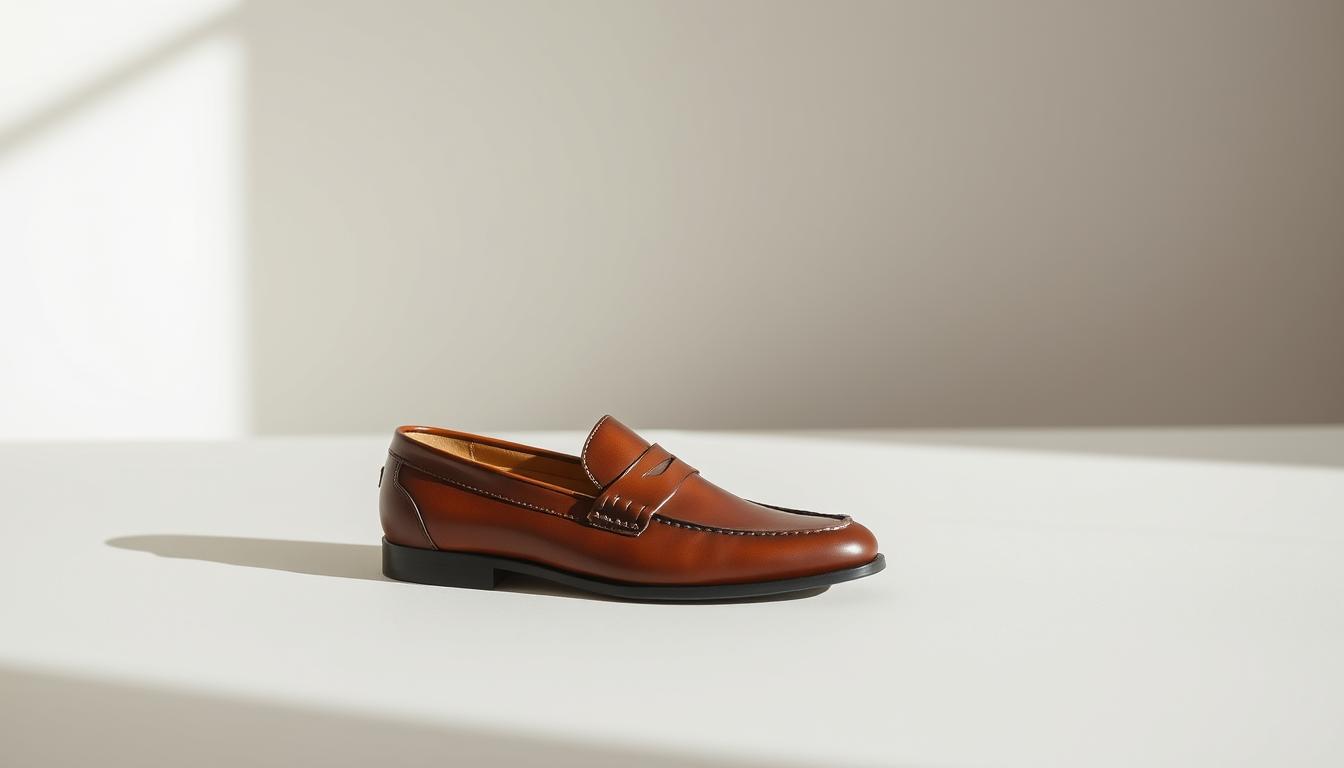Learning how to wear a belt can change your whole look. It can make your style go from good to great. Belts help define your waist, add personality, or polish your look.
Belts are more than just useful accessories. They are key style tools that can boost your fashion. You can pick from sleek leather for work or bold styles for everyday wear. Knowing how to wear a belt is essential for anyone who loves fashion.
The belt you choose can make or break your outfit. The right belt can balance your look, highlight your best features, and unite your outfit. Whether it’s for work, a night out, or a weekend, understanding belt styles helps you make stylish choices.
Key Takeaways
- Belts are versatile accessories that can transform any outfit
- Choose belt width based on your body type and outfit
- Match belt color and material to your overall look
- Consider the occasion when selecting a belt style
- Proper belt fit is key for a polished look
Understanding Belt Basics: Types and Functions
Belts are more than just accessories—they’re key style statements. They can make any outfit better. Knowing about belt styles and sizing is key to looking polished and intentional.
Let’s dive into the world of belts. We’ll look at their main features and uses. This will help you become a belt expert.
Dress Belts vs. Casual Belts
Belts come in different types. We mainly have two:
- Dress Belts: Sleek, made from real leather, simple designs
- Casual Belts: More relaxed, made from various materials, wider, and have creative buckles
Understanding Belt Width and Length
Belt sizing is more than just numbers. Here are important points:
- Dress belts are usually 1 to 1.5 inches wide
- Casual belts can be up to 2 inches wide
- Measure your waist and add 2-3 inches for the right size
Essential Belt Terminology
Get to know these important belt parts:
- Keeper Loop: Small loop for holding extra belt length
- Buckle: Metal or leather part for securing
- Strap: The main leather or fabric part
Learning these basics will change how you pick belts. You’ll choose the perfect one for any event.
How to Choose the Right Belt Size
Finding the perfect belt size can change your whole look. Knowing how to wear a belt and understanding belt sizing is key for a polished look. The right belt not only keeps your pants up but also adds a stylish touch to your outfit.
- Measure your waist at the point where you typically wear your pants
- Add 2 inches to your waist measurement for leather belts
- Add 1-1.5 inches for fabric or stretchy belts
Finding the right belt size can be hard, but we have some tips to help. A well-fitted belt should have about 3-4 inches of “tail” after buckling. This makes your look clean and professional without too much extra.
| Waist Size | Recommended Belt Size | Tail Length |
|---|---|---|
| 30-32 inches | 32-34 inches | 3-4 inches |
| 33-35 inches | 35-37 inches | 3-4 inches |
| 36-38 inches | 38-40 inches | 3-4 inches |
Different pant styles need different belt sizes. Slim-fit pants need a precise fit, while relaxed styles offer more room. Always try your belt with the pants you plan to wear for the best look and comfort.
Pro tip for belt sizing: If you’re between sizes, always choose the larger one. You can always make more holes with a leather punch, but a belt that’s too small won’t work.
Belt Materials and Their Characteristics
Choosing the right belt material can change your style and comfort. It’s important for both work and casual days. Knowing about belt materials helps you make a good fashion choice.
Different belt materials have unique qualities. They affect how long they last, how they look, and how they perform. Let’s dive into the world of belt materials that can upgrade your wardrobe.
Leather Varieties and Quality
Leather is the top choice for belts. Here are the most common types:
- Full-grain leather: The best quality, showing natural grain and getting better with age
- Top-grain leather: A bit processed but durable and stylish
- Genuine leather: A more affordable choice with good durability
Synthetic and Alternative Materials
There are new belt materials beyond leather. Here are some modern options:
- Vegan leather made from recycled stuff
- Nylon webbing for sporty and casual looks
- Canvas belts for a relaxed, comfy vibe
Weather-Appropriate Belt Choices
How you care for your belt depends on the material and the weather. Leather needs different care than synthetic materials. Here are some tips:
- Waterproof synthetic belts for rainy days
- Breathable materials for hot weather
- Thick leather belts for cold winters
Knowing about belt materials helps you pick the right one. Your belt is more than just an accessory. It shows your personal style.
Matching Belt Colors with Your Outfit
Learning how to wear a belt is more than just a practical skill. It’s an art that can change your whole look. The right belt color can make your outfit stand out and look great together.
Here are some tips for picking belt colors:
- Match your belt to your shoes for a classic, polished appearance
- Create contrast with complementary colors for visual interest
- Use neutral belt colors as a versatile style anchor
For formal events, follow traditional color rules. Black leather belts pair perfectly with black or dark dress shoes. Brown belts go well with earth-toned clothes and shoes. These choices make your outfit look elegant and put-together.
Casual outfits let you get creative with belt colors. Try out new color combinations to show off your style. A navy belt can brighten up khaki pants, while a burgundy leather belt adds depth to gray clothes.
Tip for belted outfits: Think about your body type when choosing belt colors. Darker belts can slim you down, while lighter colors highlight certain parts of your body.
- Dark belts: Create a streamlined look
- Light or bright belts: Add visual interest and break up monochromatic outfits
- Metallic belts: Work great for adding a touch of glamour
Fashion is all about expressing yourself. These tips are a good starting point, but don’t be afraid to try new things. Find what makes you feel good about yourself.
How to Wear a Belt with Different Clothing Styles
Learning to wear a belt is an art that can change your whole look. We’ll show you how to wear a belt with different clothes. This will help you improve your style with confidence.
Belts are great accessories that can really make your outfit better. Knowing how to use belts with different clothes is key to good styling.
Formal and Business Attire
In formal settings, belts are very important. Choose leather belts with simple buckles that go well with your suit or dress pants. Always match your belt color with your shoes.
- Choose dark brown or black leather belts
- Select slim, understated buckles
- Ensure belt width matches trouser belt loops
Casual and Weekend Looks
For weekend outfits, you can get creative with belts. Try different textures, colors, and styles to make your casual look unique.
- Try canvas or fabric belts for casual settings
- Pair colored belts with neutral clothing
- Use statement buckles to express individual style
Athletic and Sporty Ensembles
Belts can also add style to your athletic wear. Look for belts that are adjustable and comfortable. They should fit your active lifestyle.
- Select elastic or nylon performance belts
- Choose quick-release buckles for convenience
- Consider belts with hidden pockets for essentials
The secret to wearing a belt well is knowing how it fits with your outfit. Each style gives you a chance to show off your fashion sense.
Understanding Belt Buckle Styles
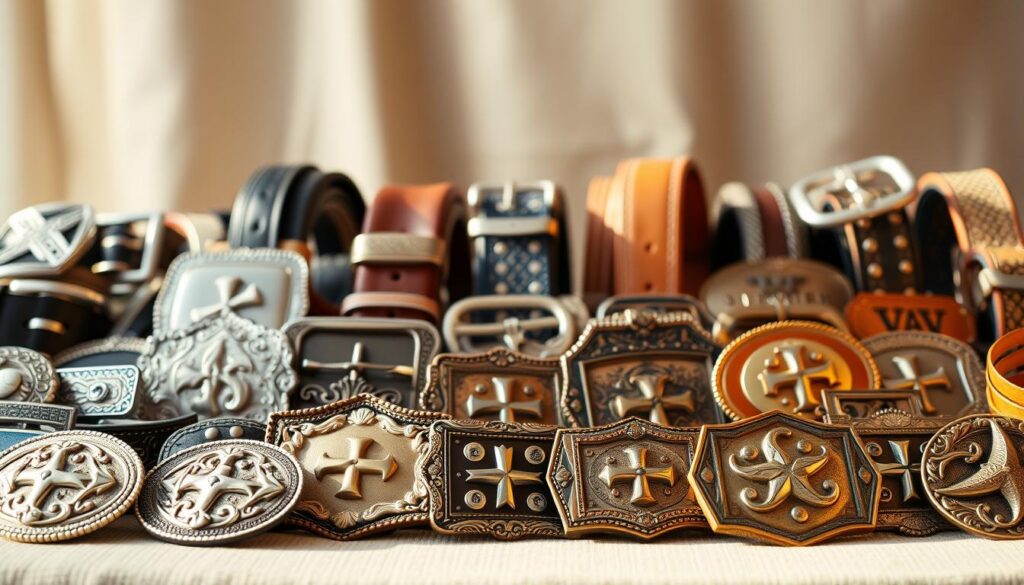
Belt buckles are more than just fasteners. They’re a key fashion statement that can change your look. Whether it’s for a formal event or a casual day, the right buckle can make a big difference.
Let’s dive into the world of belt buckles and accessories. They can help you create unique styles:
- Frame Buckles: Classic and versatile for everyday wear
- Plate Buckles: Bold statement pieces for fashion enthusiasts
- Sliding Buckles: Sleek and modern design options
- Interchangeable Buckles: Maximum flexibility for style lovers
When picking belt buckles, keep these points in mind:
| Buckle Type | Best For | Style Impact |
|---|---|---|
| Rectangular Frame | Business Attire | Professional and Understated |
| Western Plate | Casual Wear | Bold and Expressive |
| Minimalist Sliding | Contemporary Outfits | Sleek and Modern |
Pro tip for belt accessories: Get a few interchangeable buckles. A single high-quality leather belt with multiple buckle options can change your look instantly.
Remember, belt buckles should match your outfit and style. From simple metal to decorative designs, there’s a buckle for every fashion sense.
Women’s Belt Styling Tips and Trends
Belts are more than just accessories. They are powerful style statements that can change any outfit. Our guide to belt trends will show you how to use these versatile pieces to boost your wardrobe.
Statement Belts and Fashion-Forward Looks
Choosing the right belt can make a big fashion statement. Belted outfits can instantly make your style better, whether it’s a simple dress or a complex layered look. Here are some trending options:
- Wide corset-style belts that cinch waistlines
- Metallic statement belts with unique buckles
- Embellished leather belts with detailed designs
Waist-Defining Techniques
Strategic belt placement can create stunning silhouettes. The right belt can visually transform your body shape, making curves or slimming your figure. Try these waist-defining techniques:
- Wear a slim belt over blazers to create definition
- Use wide belts to break up monochromatic outfits
- Experiment with belting dresses at the natural waistline
Layering with Belts
Layering belts is an art form that adds depth and intrigue to your outfit. Mix textures, widths, and styles to create unique belt trends that show your personal creativity. Pro tip: Don’t be afraid to experiment with multiple belts or unexpected combinations.
Men’s Belt Etiquette and Guidelines
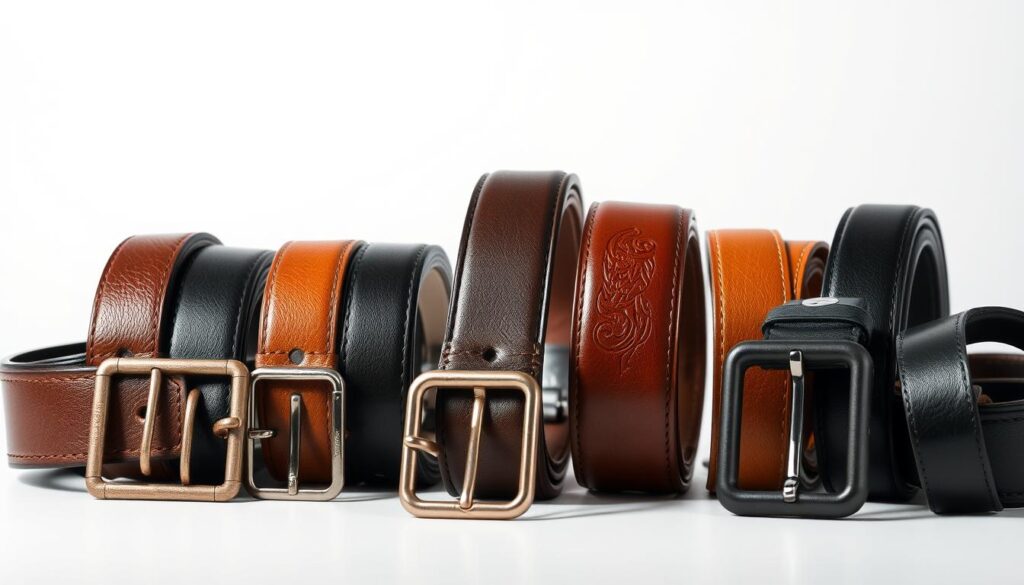
Learning how to wear a belt is like mastering an art. It can make any man’s outfit stand out. The right belt style is key to showing off your personal style and looking sharp in any setting.
Here are some important tips for choosing belt styles:
- Match your belt color to your shoes for a cohesive outfit
- Choose leather belts for formal occasions
- Opt for width appropriate to your body type
- Ensure proper belt length – no more than 1-2 inches past the buckle
Getting belt etiquette right is all about the little things. Dress belts should be sleek and narrow, usually 1-1.5 inches wide. Casual belts can be wider and more laid-back.
In professional settings, details matter a lot. A good belt can change your whole look, showing you’re put together and stylish. For work clothes, go for classic leather belts in colors like black, brown, or dark navy.
Your belt is more than just something to hold up your pants. It’s a way to show off your style and care for the little things.
Seasonal Belt Wearing Guide
Choosing the right belt for each season is key. Our guide helps you pick the perfect one for every weather and outfit. This way, you stay stylish and practical.
Choosing a belt is more than looks. It’s about fitting the season and showing your style. Your belt can change an entire look, from light summer styles to strong winter pieces.
Summer Belt Fashion
Summer belts are all about being light and breathable. Here are some top picks:
- Woven cotton belts in neutral tones
- Braided leather belts with metallic accents
- Colorful canvas belts for casual looks
Pro tip: Pick belts that don’t get wet easily and handle sweat well in summer.
Winter Belt Selections
Winter belts need to be tough and warm. Look for belts that match your layered outfits:
- Thick leather belts with sturdy buckles
- Suede belts in deep, earthy colors
- Embossed leather belts with detailed designs
For winter, choose belts that can handle cold and wet weather.
Belt Care and Maintenance Tips
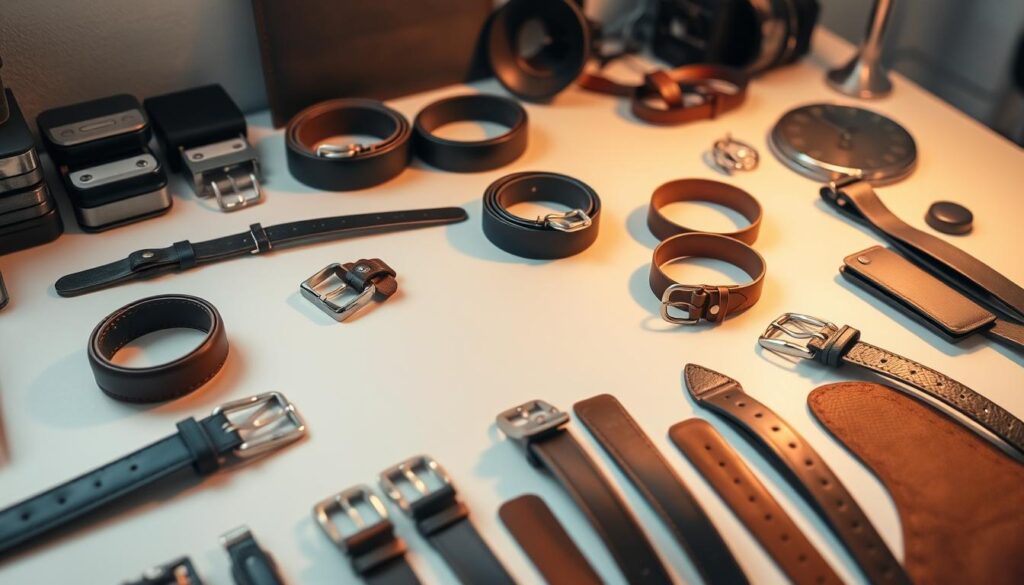
Proper belt care is key to keeping your accessories looking great. Each belt material needs its own care to last long and stay in top shape.
Our expert guide will show you how to protect your belts. Learning how to care for different materials can make your belts last longer.
Essential Belt Care Strategies
- Clean leather belts with specialized leather conditioners
- Store belts in cool, dry places away from sunlight
- Use protective sprays for synthetic belts
- Switch up which belt you wear to avoid too much wear
Every belt material needs its own care. Leather belts need conditioning to avoid cracking. Synthetic belts might need different cleaning methods.
| Belt Material | Cleaning Method | Maintenance Frequency |
|---|---|---|
| Genuine Leather | Leather cleaner, soft cloth | Every 3-4 months |
| Suede | Specialized suede brush | Monthly |
| Synthetic Materials | Mild soap, damp cloth | As needed |
Pro tip: Always check the care instructions for your belt. Preventative maintenance is key to preserving your belt’s appearance and structural integrity.
Emergency Belt Repair Tips
- Fix minor scuffs right away with leather polish
- Use leather glue for small tears in leather belts
- Replace buckles if they show a lot of wear
By following these care tips, your belts will stay stylish and useful for a long time. A little maintenance goes a long way in keeping your belts looking sharp.
Common Belt Wearing Mistakes to Avoid
Learning to wear a belt is more than picking the right accessory. It’s about mastering the art of belt styling. Even those who know fashion well can make mistakes that ruin their look.
Getting the belt size right is key to looking polished. Our guide will show you how to avoid common mistakes and improve your belt style.
Fit and Positioning Errors
The most important thing about wearing a belt is getting the fit right. Here are some common mistakes to avoid:
- Wearing a belt too loose, causing unsightly bunching
- Selecting a belt that’s too tight, creating uncomfortable pinching
- Positioning the belt at an incorrect waistline
- Choosing a belt length that doesn’t match your body type
Style Coordination Blunders
Style is just as important as fit when it comes to belts. Be careful of these coordination mistakes:
- Mismatching belt color with shoe leather
- Wearing casual belts in formal settings
- Selecting inappropriate belt width for your outfit
- Ignoring the occasion when choosing a belt
By knowing these common mistakes, you can turn your belt into a key style piece. It will enhance your whole look.
Special Occasion Belt Selection
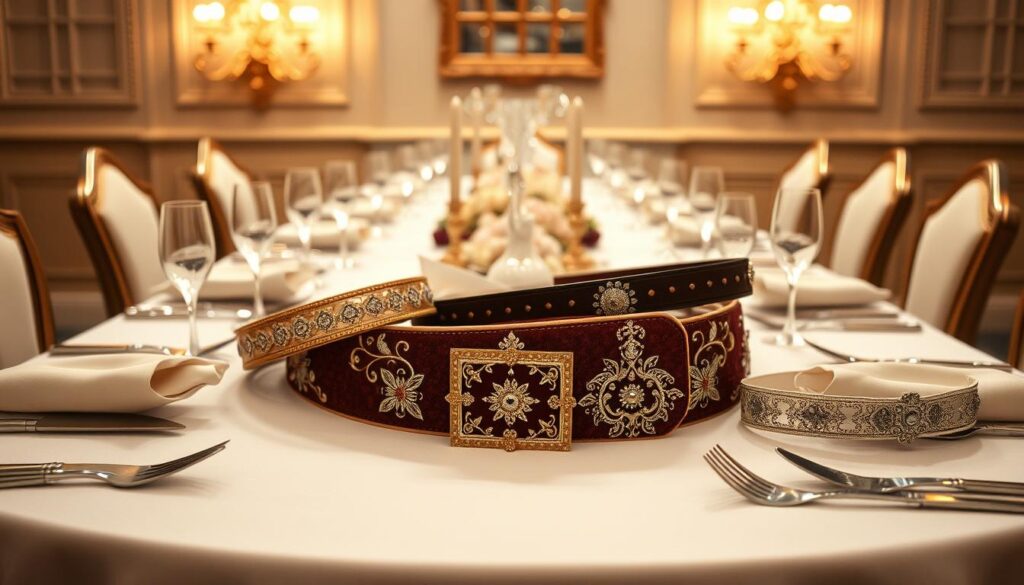
Finding the perfect belt for special events can make your outfit stand out. Our guide will show you how to pick the best belt for memorable moments.
Each event calls for a different belt style. For formal events, choose belts that match your outfit but don’t overshadow it. A simple leather belt is great for black-tie events. But, a bold belt can add flair to more casual looks.
- Gala and Formal Events: Choose slim, polished leather belts with understated metallic buckles
- Outdoor Weddings: Opt for textured or braided belt styles that match natural settings
- Professional Networking: Select neutral-colored belt accessories that demonstrate sophistication
Designer belts can instantly change your look. Look for belts with small crystals or unique buckles for evening events. These belts catch the eye without overwhelming your outfit.
Pro tip: Get belts that work for both day and night. A good belt can turn a simple outfit into something special with little effort.
The right belt is all about balance. It should boost your outfit, show off your style, and make you feel confident at any event.
Alternative Ways to Style Belts
Belts are more than just useful accessories. They are also a way to express your style. Our experts have found new ways to use belts, making them more than just a waist cincher. They bring creativity and personal flair to your outfits.
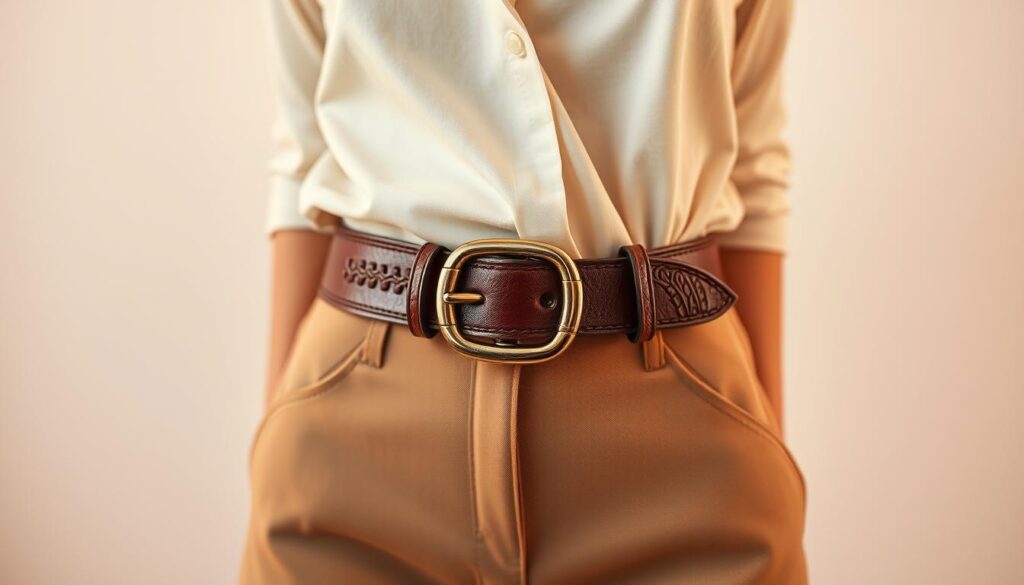
Ready to try something new with belts? Let’s dive into some exciting ways to style them:
- Create a layered look by wearing belts over blazers or long coats
- Use belts as decorative harness-style accessories
- Experiment with unique belt loops and fancy knot designs
- Turn belts into bold hair accessories
Creative Belt Loops and Knots
Belt loops are not just for holding belts. They’re a canvas for creativity. Here are some cool ways to make your belt loops pop:
- Double-loop method for added texture
- Asymmetrical knot styling
- Braided belt loop techniques
- Decorative bow configurations
Non-Traditional Belt Placement
Try something different with belt placement. You can wear belts diagonally over dresses, as shoulder accessories, or at unique angles for a dramatic look.
With these ideas, you can turn simple belts into bold fashion statements. They will show off your unique style.
Conclusion
We’ve covered everything about belts in our guide. From the basics to creative styling, you’re ready to boost your style. Belt trends change often, and now you know how to keep up.
Choosing and styling belts is more than fashion—it’s a way to express yourself. The right belt can change your whole look. We’ve given tips on colors, materials, and avoiding mistakes.
Fashion is about trying new things and feeling great. Don’t be scared to break rules and show off your style. Our guide is just a start. Use your creativity and wear belts with confidence and flair.
Your wardrobe is ready for a belt makeover. With these tips, you’ll look sharp, confident, and in style. Fashion is a journey, and your belt is your stylish friend.


